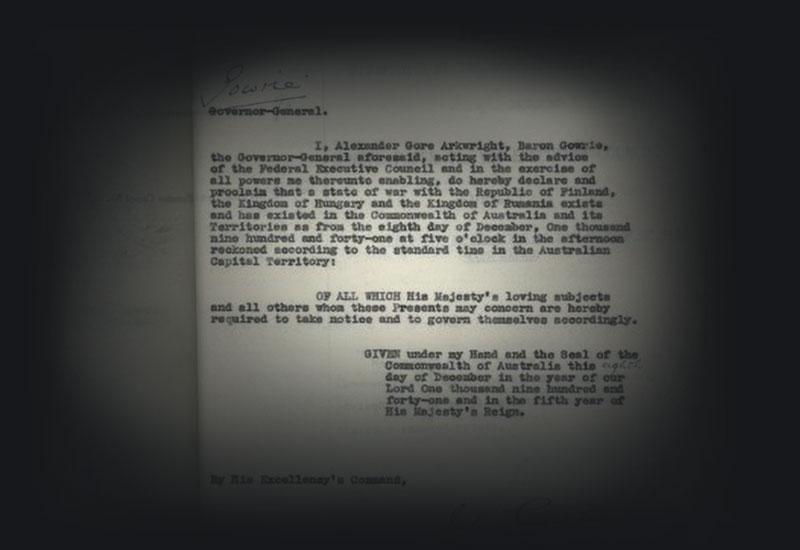They are some of the most important documents in Australia’s evolution as an independent nation. But, for 80 years, they've gone largely unnoticed, filed away in a bound volume of Executive Council minutes.
This is the story of Australia’s first declarations of war.
A powerful and solemn act
Historically, declaring war was regarded as one of the most powerful and solemn acts of sovereignty an independent nation could exercise on the world stage. It was a power Australia traditionally lacked because of its colonial status within the British Empire. So, in August 1914, once Britain declared war on Germany, Australia was automatically at war too.
By the 1930s, Australia’s status had evolved into that of a ‘dominion’ – a self-governing member of the British Commonwealth with full autonomy in internal and external affairs, equal to that of Britain itself. Yet, when war broke out again with Germany in September 1939, Prime Minister Robert Menzies famously announced:
it is my melancholy duty to inform you officially that in consequence of a persistence by Germany in her invasion of Poland, Great Britain has declared war upon her and that, as a result, Australia is also at war [emphasis added].
However, in late 1941, the new prime minister, John Curtin, took a very different view when Britain was declaring war against Finland, Hungary and Romania (3 of Nazi Germany’s satellite states). Although he concurred with Britain’s course of action, he asserted that Australia would make its own declaration of war.
To do this, the Curtin government formally advised the King to officially assign the power to declare war to the Governor-General. Confirmation of the King’s assent was then telegraphed immediately from London to Australia so that the Cabinet could then advise the Governor-General to declare war.
Doing the deed in Melbourne
On 8 December 1941, Governor-General Lord Gowrie VC, Prime Minister John Curtin and senior Cabinet ministers gathered at Victoria Barracks, Melbourne, for a meeting of the Federal Executive Council. Lord Gowrie signed a proclamation officially declaring war on Finland, Hungary and Romania. The document was then countersigned by Prime Minister Curtin and quickly published in the Gazette. It was the first time Australia had ever declared war separately to Britain.
With no prospect of Australian ‘boots on the ground’ against any of these countries, this declaration of war was largely symbolic. That does not diminish its significance as a declaration of Australian independence on the world stage.
We are at war
Of course, this important milestone in Australia’s evolution as an independent nation was immediately overshadowed by Japan’s attack on Pearl Harbour, Hong Kong and Malaya, which had occurred earlier that morning (Australian time). So, when Prime Minister Curtin told the nation that evening that 'we are at war', he was referring to Japan, not 3 remote European countries. The next day, 9 December 1941, the Governor-General formally signed the declaration of war against Japan too.
The next few months were dark days for Australia, with the Japanese advancing quickly southwards. The imperative of defending Australia led to the Curtin government exerting even more independence of action from Britain. John Curtin stood up to British prime minister Winston Churchill to ensure that the Australian Imperial Force was brought home. He also turned to the United States of America for help.
As for the actual declarations of war, these were later bound in the volumes of approved Federal Executive Council minutes. These significant documents in Australia’s evolution as an independent nation are now preserved as part of the National Archives’ collection in Canberra.













